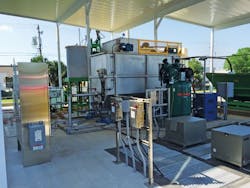Food & Beverage: Cream of the Crop
About the author: Oren Gruber is wastewater treatment manager at Ecologix Environmental Systems. Gruber can be reached at [email protected] or 678.514.2100.
One of the Southeast’s largest ice cream processors approached Ecologix Environmental Systems to help it solve a problem with excessive fats, oils and grease (FOG) in its effluent wastewater. The levels of FOG in the wastewater were far above the county’s limits and were causing problems in the county’s lift stations. As a result, the county had given the plant a deadline of six months to fix the issue or face closure of the facility altogether. Furthermore, an odor problem also lingered around the processor’s old wastewater treatment system because it was undersized and overwhelmed with high-strength wastewater.
The Challenge
To prevent closure of the plant, the level of fats in its wastewater needed to be reduced to allowable standards mandated by the local county.
The plant also required assistance with the permitting of its new wastewater treatment system with the county authorities. Without the new permit, the plant would not be able to operate its new treatment system.
Lastly, offensive odor produced by the biological treatment system also needed to be eliminated.
New System Needed
After the ice cream processor consulted with Ecologix about the issues at hand, it was determined that an entirely new treatment system would be required to bring the plant into full compliance and solve the problems associated with the wastewater. The company also would provide full support in helping acquire the proper permits from the county to construct and operate the new treatment system.
Ecologix designed and fabricated a physical/chemical treatment system that included an equalization tank, continuous removal of free-floating fats, chemical reaction tanks, a dissolved air flotation (DAF) system and sludge dewatering. The entire system was designed and fabricated in-house, as was the handling of the wastewater system permitting process for the client.
The old, failing system was demolished and replaced with a system that removes FOG and suspended solids, reduces biochemical oxygen demand (BOD) and eliminates offensive odors.
The deadline set by the county was met and the creamery has continued normal operations since installation.
Results
- FOG levels from the plant were reduced from an average of 1,290 mg/L to less than 10 mg/L;
- Total suspended solids (TSS) levels were reduced by more than 99%; and
- Biochemical oxygen demand (BOD) was reduced by almost 45%.
All of the above were accomplished using a primary treatment system. No secondary or tertiary treatment has been incorporated.
Independent lab results of the ice cream facility’s influent wastewater (before treatment) and effluent wastewater (post-treatment) at the plant are shown above.
Download: Here
